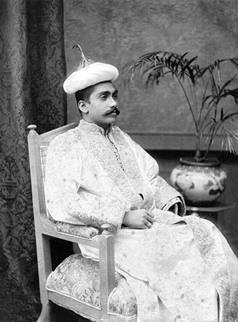
His
Royal Highness Maandoogey Tuttu Manippulu dressed in the
full State regalia of Prince Regent, March 1901 in Male
Maldives
|
Prince
Ahmed Maandoogey Tuttu Manippulu was the youngest son of Sultan
Hassan Izzuddine Maandoogey Bodudorhy Manippulu, elder son of
King Kula Sundhura Siyaaka Saasthura Audha Keerithi Bovana (Sultan
Mohamed Imaduddine IV Iskander).
He
was born on 27 January 1877 at Kambaafaanu Ganduvaru
(this was a secondary royal palace dedicated as a maternity
residence for senior royals. Kambaafaanu Ganduvaru means
Princess Palace) in Male.
His
mother was Maandoogey Don Didi daughter of Ahmed Didi son of
Moosa Didi son of Huraa Mureedugey Hussain Dorhimeynaa Kilegefan,
a descendant of King Manoel
Dhirikusa Loka (Sultan Hassan IX) through Dom
Luis de Sousa.
Maandoogey
Tuttu Manippulu was born in the reign of his grandfather King
Siri Kula Sundhura Siyaaka Saasthura Audha Keerithi Bovana.
When the old king died after the longest unbroken reign recorded
in Maldive history, his elder son Hassan Izzuddine Maandoogey
Bodudorhy Manippulu was elevated to the full rank of sultan,
but had to share this role with his younger brother Ibrahim
Nooreddine.
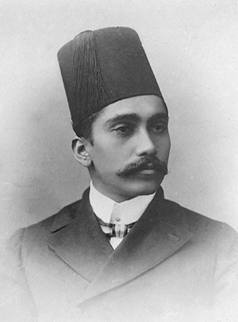
Prince Maandoogey Tuttu Manippulu dressed in the contemporary
attire of the Ottoman nobility
2 May 1901 in Male, Maldives
|
The
elder prince was incapacitated from discharging the duties of
sultan as his vision was almost totally impaired from a very
early age due to a medical misadventure.
Notwithstanding
this, Hassan Izzuddine had all the rights and prerogatives of
Sultan and was in residence at the Eterekoilu, the seat
of the Sultans. In all official ceremonies and records, including
the plaque on his tombstone he was addressed as Sultan.
In
those days (until 1963) a proclamation- benediction called taania
was read out at Friday services at mosques throughout the realm.
The taania mentioned the reigning Sultan by name.
In the lifetime of Hassan Izzuddine Maandoogey Bodudorhy Manippulu,
his name was mentioned in the taania as co-Sultan.
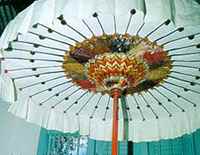
The
Royal parasol called
Haiykolhu or Isfaalha
|
Maandoogey
Tuttu Manippulu grew up with all the royal honours of the time.
He was entitled to gun salutes, fanfares and full State processions.
State ceremonies performed for him with full royal honours included
his circumcision ceremony, private school graduation ceremony,
State parasol ceremony, first sea voyage ceremony, and weddings.
When
Tuttu Manippulu was about 16 years of age, his eldest brother
assumed the throne as King-Sultan Mohamed Imaduddine VI Iskander
(more commonly known as Haji Imaduddine). Tuttu Manippulu and
his middle brother Maandoogey Dorhy Manippulhu were declared
co-heirs apparent and shared many royal duties with their eldest
brother the new Sultan.
For
this reason that era bacame known as the era of the "Maandoogey
Kingdom". When the Sultan was out of the capital, one
of the younger princes performed the day-to-day duties of State.
When the Sultan went abroad to perform the haj, he took the
elder of his younger brothers with him and Maandoogey Tuttu
Manippulu assumed the powers of King-Sultan as Prince Regent.
There were several contenders to the throne at that time. When
the King-Sultan went abroad, there was much jostling for power.
The young Prince Regent tread a fine line and kept order among
the great nobles who had divided loyalties. He was successful
in warding off the contenders and managed to preserve the throne
for his brother.
Subsequently
when the Sultan travelled abroad to marry an Ottoman lady in
Suez, the role of regent fell on the elder of his younger brothers,
Maandoogey Dorhy Manippulu who obviously lacked the tact and
political acumen of his younger brother Maandoogey Tuttu Manippulu.
Dorhy Manippulu soon lost his elder brother's throne to one
of the contenders, Muleegey Manippulu who assumed the throne
as King Siri Kula Sundhura Katthiri Bavana (Sultan Mohamed Shamsuddine
III).
Maandoogey
Tuttu Manippulu was an accomplished fine artist. He excelled
in the art of designing gold and silver jewellery and was a
recognised master of that craft- the leading authority
of his time. He designed and sometimes hand-crafted fine jewellery
for his wives, daughters and relations.
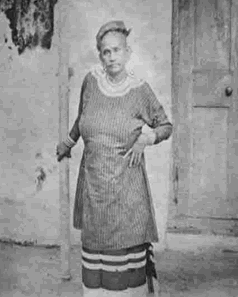
Her
Royal Highness Maandoogey Don Didi |
He
was the first person to introduce photography to the Maldives,
which was later banned by the new regime. However he ignored
the ban and continued to maintain a studio at his residence.
The first photograph taken and developed in the Maldives by
a local photographer was by Maandoogey Tuttu Manippulu of his
mother Maandoogey Don Didi. This photograph has survived to
this day and is published here.
His
other artistic talents included turning wood into the traditional
lacquered vases and vessels of the Maldives. He was also a talented
musician, particularly of the classical Maldive styles.
Maandoogey
Tuttu Manippulu was the first Maldivian to own and operate a
radio receiver in the Maldives. This was an illegal operation
at that time as the new government did not allow such activity,
particularly by a member of the deposed sultan's family. He
had a massive aerial towering over his residence. Officials
apparently served several warrants to have the antenna removed,
but Tuttu Manippulu insisted that it was a device to help him
have his kites airborne. No kites were ever seen to fly from
that mast. The bewildered officials were not too sure and their
bosses, who knew better, were too timid to have the thing forcibly
removed. So he kept enjoying braodcasts from the outside world.
Maandoogey
Tuttu Manippulu was of a congenial nature. He spoke in a confident
voice and laughed out loudly often. He had a good sense of humour
and often played light-hearted pranks.
After
King-Sultan Mohamed Imaduddine VI Iskander was deposed in favour
of his cousin, the Maandoogey princes and their families had
to endure much hardship and humiliation. They were, however,
offered an "olive branch" more than once by those
connected with the new regime. Notwithstanding this they seemed
to lack the foresight to take advantage of such offers at that
time. Had this not been the case, the delicate balance of power
would surely have swayed in their favour. This was not to be.
Having
decided that the star of his good fortune had set, a frustrated
Maandoogey Tuttu Manippulu decided to go into self-imposed exile
in Ceylon. After several years of unsuccessfully seeking an
exit visa from the Maldives, he travelled to Colombo in 1925.
Maandoogey
Tuttu Manippulu married three ladies. They were, Velaanaagey
La Didi daughter of Malingey Hassan Velaanaa Manikfan, Maaveyodorhugey
Sanfa Didi daughter of his step-mother Kahambugey Bodu Didi
and Aa Ganduvaru Tuttu Goma, daughter of his uncle Sultan Ibrahim
Nooreddine. The first two ladies bore him a total of eight children.
While
he was in self-imposed exile in Colombo, his brother's successor
Mohamed Shamsuddine III was forced to abdicate from the throne
by a new government led by Shamsuddine's nephew Hassan Farid
Didi, who was the virtual dictator at that time. Samsuddine
was succeed by Maandoogey Tuttu Manippulu's nephew Maajehi Ganduvaru
Manippulu as King Siri Kula Sudha Ira Siyaaka Saasthura Audha
Keerithi Katthiti Bovana (Sultan Hassan Nooreddine II). Hassan
Farid Didi was married to Maandoogey Tuttu Manippulu's youngest
daughter Tuttudon Goma. Hassan Farid Didi soon sent word to
Colombo and brought his father-in -law back.
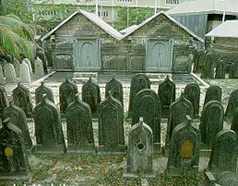
The
Royal Enclosure of the graveyard of the Hukuru Miskit
in Male: Tombs of mainly Huraagey kings, princes and princesses
|
With
his nephew on the throne, and his son-in-law as virtual head
of the government, Maandoogey Tuttu Manippulu regained all his
royal honours and prerogatives and took up residence at Uthuru
Ganduvaru (now part of the defence headquarters).
Maandoogey
Tuttu Manippulu died aged 69 (71 according to the lunar calendar)
on 9 May 1946. The militia were summoned by drum roll, as royal
protocol dictated, and he was buried with full princely honours
at the royal burial enclosure at Male's Hukuru Miskit,
next to his father's tomb.
Maandoogey
Tuttu Manippulu was my paternal grandfather.

